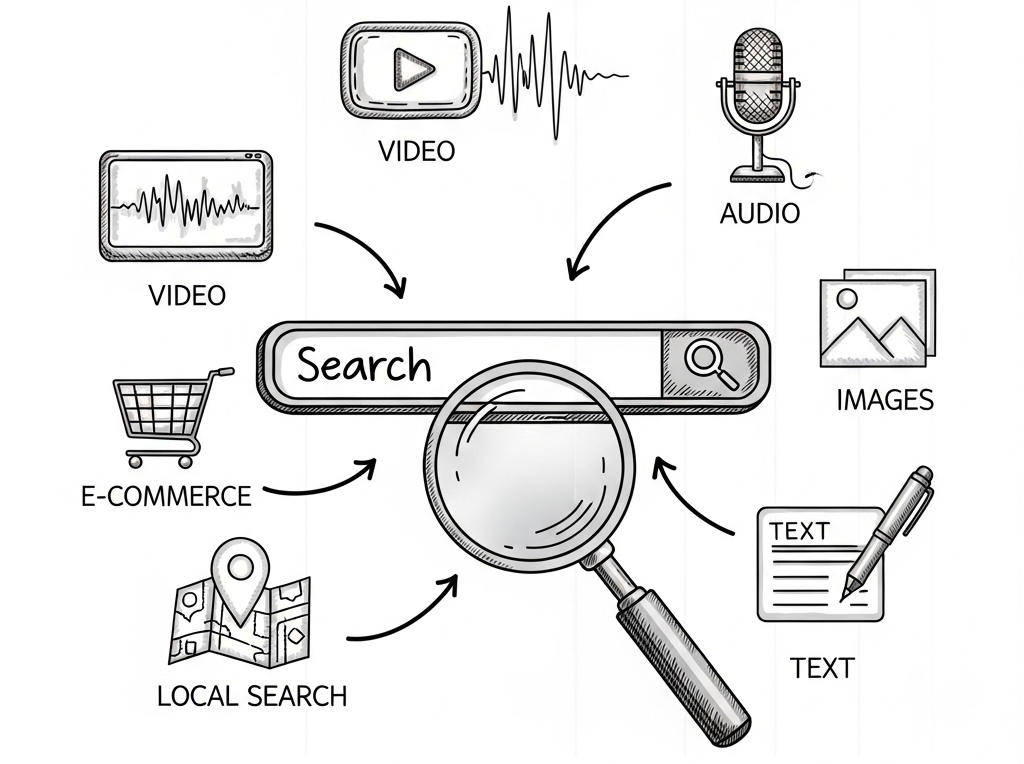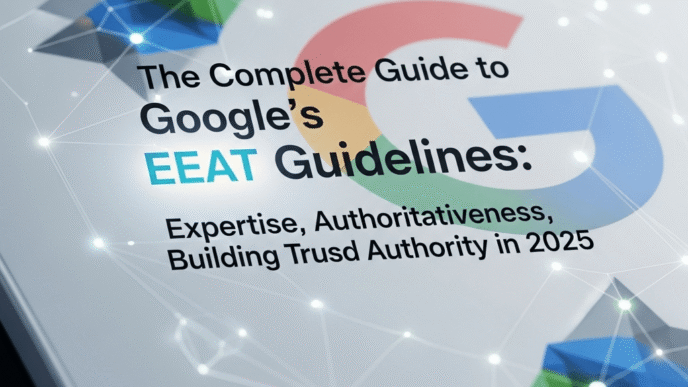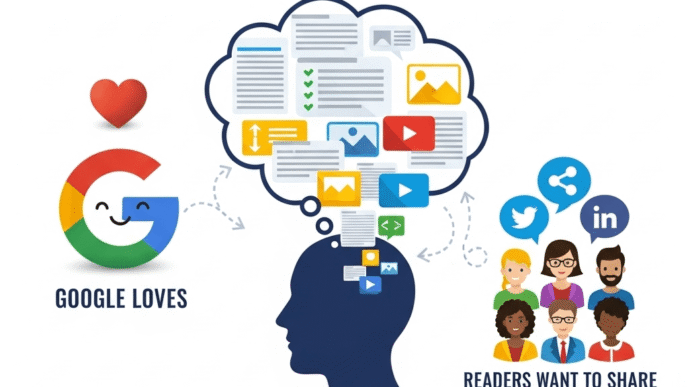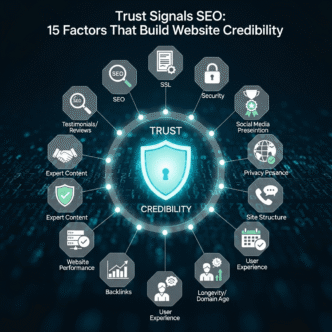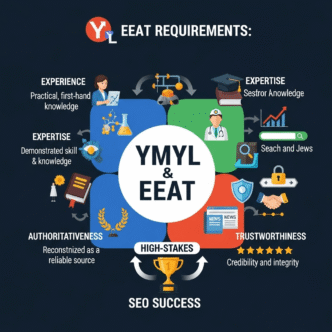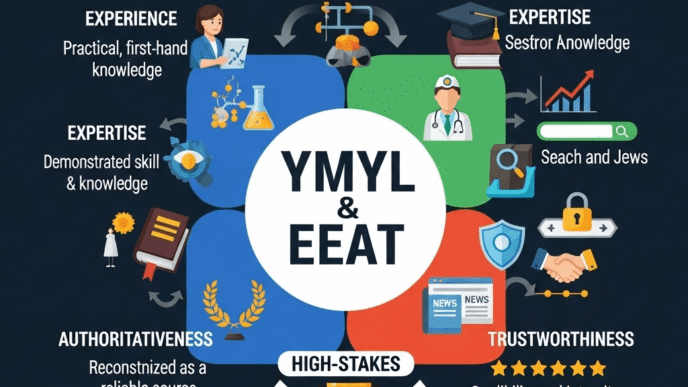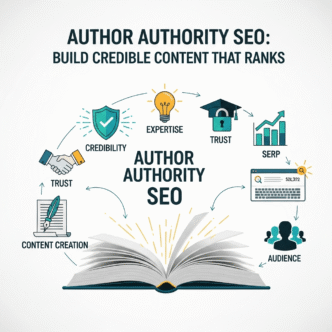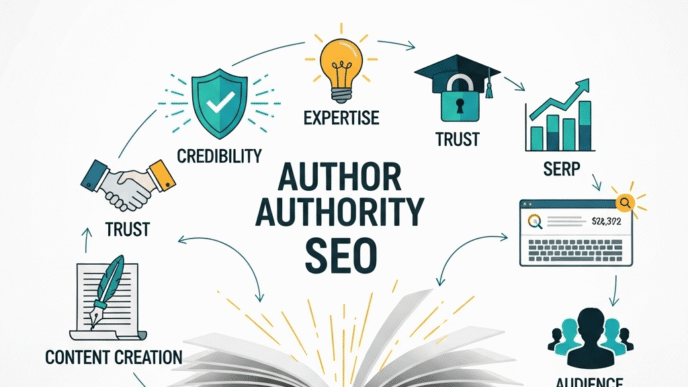You’ve probably noticed something interesting happening in your content analytics lately. Traditional blog posts are getting traffic, but the real engagement winners? They’re the pieces that work seamlessly across voice search, visual discovery, and conversational platforms.
Welcome to the era of Multi-Modal Content Creation – where smart creators craft content that doesn’t just rank in Google, but gets discovered through Alexa, Pinterest Lens, TikTok search, and emerging AI platforms. Think of it as being fluent in multiple “content languages” simultaneously.
With 90% of content marketers planning to use AI in their 2025 strategies and short-form video delivering the highest ROI according to recent data, the content game has fundamentally changed. Let’s dive into how you can master content optimization strategies that capture attention everywhere your audience searches.
Table of Contents
Toggle
What Makes Multi-Modal Content Creation Different?
Multi-Modal Content Creation isn’t just about repurposing one blog post into different formats. It’s about strategically crafting content that serves multiple search behaviors from the ground up.
Traditional content targets text-based Google searches. Multi-modal content anticipates how people actually discover information today: asking voice assistants questions while cooking, snapping photos to find similar products, or scrolling through visual feeds for inspiration.
The numbers tell the story: short-form video (29.18%) now outpaces images (28.95%) as the most popular content format used by marketers, while blog posts rank fourth at 19.47%. Yet the most successful creators aren’t abandoning text – they’re weaving it into cross-platform content strategy that works everywhere.
How Do You Write Content That Voice Assistants Love?
Voice search content writing requires a complete mindset shift. When someone types, they search “SEO tips.” When they speak, they ask “What are the best SEO tips for small businesses in 2025?”
Voice queries are conversational, question-based, and often include context. Your content needs to mirror this natural speech pattern while maintaining the depth that builds authority.
The secret sauce? Structure your content to answer the questions people actually ask out loud, not just the keywords they type.
Step-by-Step Voice-Friendly Content Creation
Step 1: Research Conversational Keywords
Start with tools like AnswerThePublic, but don’t stop there. Listen to how your customers naturally describe their problems during sales calls or support conversations.
Create a question bank around your topic:
- “How do I…” (process questions)
- “What’s the best way to…” (method questions)
- “Why does…” (explanation questions)
- “When should I…” (timing questions)
Step 2: Structure for Voice Consumption
Voice-friendly copywriting follows a specific pattern:
- Direct Answer First: Start with a clear, concise answer in 30-50 words
- Expanded Explanation: Follow with supporting details
- Actionable Steps: Break complex processes into numbered lists
- Natural Language: Write like you’re explaining to a friend
Example:
Q: How do you optimize content for voice search?
Direct Answer: Voice search optimization focuses on conversational keywords, question-based content structure, and featured snippet optimization. Target long-tail keywords that mirror natural speech patterns.
Expanded Explanation: Unlike traditional SEO, voice search users ask complete questions…
Step 3: Optimize for Featured Snippets
Featured snippets power most voice search results. Format your content with:
- Clear headings that match question intent
- Concise paragraph answers
- Bulleted or numbered lists for processes
- Definition boxes for key terms
Pro Tip: Read your content aloud before publishing. If it sounds robotic or unnatural when spoken, your voice optimization needs work.
Why Visual Content SEO Is Your Secret Growth Engine
Visual content SEO isn’t just about making pretty pictures. It’s about creating images that tell stories, drive discovery, and rank across multiple visual search platforms.
With visual content being 43% more persuasive than text alone, and platforms like Pinterest and Google Lens processing billions of visual searches monthly, optimizing your visual content strategy is non-negotiable.
But here’s what most creators miss: visual SEO isn’t just alt text. It’s about visual storytelling SEO that makes your content discoverable, shareable, and conversion-friendly.
Complete Visual Content Optimization Framework
Step 1: Plan Visual Content Strategy
Before creating any visual content, map out your multi-format content development approach:
- Infographics: For data-heavy topics that need simplification
- Process Screenshots: For tutorial and how-to content
- Quote Graphics: For social sharing and Pinterest discovery
- Product Images: For e-commerce and visual search optimization
- Behind-the-Scenes Photos: For authenticity and engagement
Step 2: Master Visual SEO Fundamentals
Every visual element needs optimization:
File Naming: Use descriptive, keyword-rich filenames
- ✅ Good: “voice-search-optimization-process-2025.jpg”
- ❌ Bad: “IMG_1234.jpg”
Alt Text Optimization: Write descriptive alt text that serves both accessibility and SEO
- ✅ Good: “Step-by-step flowchart showing voice search optimization process with smartphone and speech bubbles”
- ❌ Bad: “Voice search image”
Image Compression: Balance quality with loading speed using tools like TinyPNG or WebP format
Step 3: Optimize for Visual Discovery Platforms
Each platform has unique optimization requirements:
Pinterest:
- Vertical aspect ratios (2:3 or 3:4)
- Text overlay for context
- Keyword-rich descriptions
- Rich Pins implementation
Google Images:
- High-quality, original images
- Proper image sitemaps
- Structured data markup
- Mobile-optimized display
Instagram/TikTok:
- Consistent visual branding
- Trending hashtag research
- Story-friendly formats
- Reel-optimized dimensions
Expert Insight: The best visual content serves multiple platforms without looking like it was designed for one specific platform. Think “platform-agnostic with platform-specific optimization.”
Mastering Conversational Content Creation for AI Platforms
Conversational content creation is about writing content that AI chatbots and virtual assistants can easily understand, reference, and recommend to users.
As AI tools become primary research sources, your content needs to be structured for both human readers and machine comprehension. This means clear information hierarchy, fact-based statements, and logical content flow.
The goal isn’t to “trick” AI systems – it’s to make your expertise easily accessible to the growing number of people who discover content through AI-powered conversations.
AI-Optimized Content Structure Tutorial
Step 1: Create Clear Information Architecture
Structure your content like a well-organized reference document:
1. Main Topic Overview (what it is)
2. Key Benefits/Problems Solved (why it matters)
3. Step-by-Step Process (how to do it)
4. Examples and Case Studies (proof it works)
5. Common Mistakes to Avoid (what not to do)
6. Next Steps/Related Topics (where to go next)
Step 2: Write in Fact-Statement Format
AI systems love clear, factual statements. Structure information as definitive claims with supporting evidence:
“Multi-modal content creation increases engagement by 43% compared to single-format content. This approach works because it meets users across multiple touchpoints in their discovery journey.”
Step 3: Include Contextual Information
Provide enough context so AI can understand when and why to recommend your content:
- Define technical terms
- Explain industry-specific concepts
- Include relevant dates and statistics
- Connect ideas to broader topics
Real-World Success: Brands Winning with Multi-Modal Content
Let’s examine how successful companies implement cross-platform content strategy:
Case Study: Recipe Creator’s Multi-Modal Approach
Food blogger Minimalist Baker transformed from text-heavy blog posts to multi-modal content creation:
- Voice Optimization: Added FAQ sections answering common cooking questions
- Visual Strategy: Created step-by-step photo sequences optimized for Pinterest
- Conversational Elements: Structured recipes for voice assistant reading
- Results: 300% increase in Pinterest traffic, 150% boost in voice search visibility
Key Takeaways:
- One piece of content served multiple discovery channels
- Visual content enhanced rather than replaced written content
- Conversational structure improved user experience across platforms
Case Study: SaaS Company’s Technical Content Strategy
B2B software company Notion revolutionized technical documentation with multi-modal content:
- Voice-Friendly Structure: FAQ sections addressing “How do I…” queries
- Visual Documentation: Screenshots and GIFs for every process
- Conversational Tone: Complex features explained in simple language
- Results: 400% increase in organic search traffic, higher user adoption rates
Key Insights:
- Technical content doesn’t have to be boring or text-heavy
- Visual aids accelerated user understanding and adoption
- Conversational explanations reduced support ticket volume
What Are the Most Effective Content Optimization Strategies?
The most successful content optimization strategies create synergy between different content formats and platforms. It’s not about choosing text OR video OR images – it’s about strategically combining them.
90% of content marketers plan to use AI in their 2025 strategies, but the smartest approach combines AI efficiency with human creativity and strategic thinking.
Start with user intent mapping. What questions are people asking? How do they prefer to consume information about your topic? Then create content ecosystems that serve those preferences across multiple touchpoints.
How Do You Measure Multi-Modal Content Success?
Traditional content metrics like page views tell only part of the story. Multi-format content development requires broader measurement approaches:
Voice Content Metrics:
- Featured snippet wins
- Voice search impressions (Google Search Console)
- Question-based keyword rankings
- Answer box appearances
Visual Content Performance:
- Pinterest saves and impressions
- Google Images traffic
- Social media shares
- Visual search click-through rates
Conversational Content Indicators:
- Time on page (longer engagement)
- Scroll depth and interaction rates
- Social media mentions and discussions
- AI platform referrals (emerging metric)
Cross-Platform Measurement:
- Multi-channel attribution
- Content journey mapping
- Platform-specific engagement rates
- Overall brand mention increases
Pro Tip: Set up separate tracking for each content format to understand which multi-modal strategies deliver the best ROI for your specific audience.
Quick Start Multi-Modal Content Checklist
Ready to implement multi-modal content creation? Here’s your action plan:
Pre-Creation Planning
- Research conversational keywords and questions
- Identify primary and secondary content formats
- Map content to different platform requirements
- Plan visual elements from the beginning
Content Creation Essentials
- Write in conversational, natural language
- Structure for featured snippet optimization
- Create visual elements that enhance (not repeat) text
- Include clear headings and logical information hierarchy
Technical Optimization
- Optimize all images with descriptive alt text and filenames
- Implement structured data markup
- Ensure mobile-first responsive design
- Test voice search compatibility
Distribution Strategy
- Customize content for each platform’s algorithm
- Create platform-specific visual formats
- Optimize posting times and hashtag strategies
- Monitor cross-platform performance metrics
Common Multi-Modal Content Mistakes (And How to Avoid Them)
Mistake #1: Treating Each Format as Separate Content
Many creators write a blog post, then add images as an afterthought, then try to “convert” it for voice search. This fragmented approach misses the synergies.
Solution: Plan multi-modal from the beginning. Ask yourself: “How can this single topic serve text readers, visual discoverers, and voice searchers simultaneously?”
Mistake #2: Over-Optimizing for One Platform
Some creators go overboard with Pinterest optimization and create content that only works on Pinterest, or focus solely on voice search and neglect visual appeal.
Solution: Maintain platform balance. Your content should feel native to each platform while maintaining consistent value and messaging.
Mistake #3: Ignoring Conversational Context
Many creators optimize for search engines but forget that real people are asking real questions with specific context and urgency.
Solution: Always include the “why” and “when” context in your content. Help readers understand not just what to do, but when and why to do it.
Mistake #4: Underestimating Visual Search Impact
With visual content being 43% more persuasive than text alone, treating images as decoration rather than discovery tools is a missed opportunity.
Solution: Every visual element should serve a strategic purpose – discovery, explanation, engagement, or conversion.
Future-Proofing Your Multi-Modal Content Strategy
The content landscape continues evolving rapidly. 92% of brands plan to increase investments in content creators in 2024, and new platforms emerge constantly.
Emerging Trends to Watch:
AI-Human Collaboration: 99.6% of content marketers using AI tools by the end of 2024 plan to continue utilizing them in 2025, but the focus is shifting toward AI-human collaboration rather than replacement.
Interactive Content Growth: Calculators, quizzes, and dynamic content are becoming more important for engagement and discovery.
Micro-Content Strategies: Breaking long-form content into consumable, searchable micro-pieces that work across platforms.
Privacy-First Content: As cookies disappear, first-party content engagement becomes more valuable.
Advanced Multi-Modal Content Techniques
Content Clustering Strategy
Create content clusters around topic themes that work across modalities:
- Pillar Content: Comprehensive guide optimized for text search
- Supporting Visual Content: Infographics and process images for Pinterest/Instagram
- Voice-Optimized FAQ: Question-based content for voice search
- Video Summaries: Short-form video content for TikTok/Instagram Reels
- Interactive Elements: Tools or calculators for deeper engagement
Cross-Platform Content Adaptation
Transform one core piece of content into multiple format-specific versions:
Original Blog Post: “Complete Guide to Email Marketing”
Voice Adaptation: FAQ section answering “How do I start email marketing?” Visual Adaptation: Step-by-step infographic showing email marketing process Conversational Adaptation: Simplified explanation with analogies Social Adaptation: Key tips formatted as quote graphics
Frequently Asked Questions About Multi-Modal Content Creation
What is multi-modal content creation and why is it important?
Multi-modal content creation is the strategic process of crafting content that works effectively across different formats and discovery channels – including text search, voice queries, visual discovery, and conversational AI platforms. It’s important because modern users discover content through multiple touchpoints, and single-format content misses significant audience segments.
How do I start with voice search content writing?
Begin by researching question-based keywords your audience actually speaks aloud. Focus on conversational phrases, create FAQ sections, and structure content to answer specific questions directly. Write in natural language and test your content by reading it aloud.
What’s the difference between regular content and multi-modal content?
Regular content typically focuses on one format (usually text) optimized for traditional search engines. Multi-modal content is strategically designed from the beginning to serve multiple discovery methods and platforms while maintaining consistent value and messaging across all formats.
How important are visual elements for multi-modal content?
Visual elements are crucial – research shows visual content is 43% more persuasive than text alone. Properly optimized images, infographics, and visual aids enhance discoverability through image search, social media, and visual search platforms while improving user engagement and comprehension.
Can small businesses benefit from multi-modal content creation?
Absolutely. Small businesses often have advantages in multi-modal content creation because they can be more agile and authentic. Local businesses especially benefit from voice search optimization and visual content for local discovery. Start with one additional format and expand gradually.
How do I optimize content for AI chatbots and virtual assistants?
Structure content with clear information hierarchy, use fact-based statements, provide contextual information, and organize content logically. Write in conversational language while maintaining expertise and accuracy. Include definitions for technical terms and connect ideas to broader topics.
What tools help with multi-modal content creation?
Essential tools include Canva or Adobe Creative Suite for visual content, AnswerThePublic for voice search research, Google Search Console for performance tracking, social media scheduling tools for cross-platform distribution, and AI writing assistants for content optimization and ideas.
Ready to Transform Your Content Strategy?
Multi-modal content creation isn’t just the future of content marketing – it’s the present reality for brands that want to stay competitive and discoverable.
The data is clear: 21% of marketers say short-form video content delivers the best ROI in 2025, while 68% of businesses see an increase in content marketing ROI thanks to using AI. But the biggest wins come from strategic integration, not just following trends.
Your audience is already searching across multiple platforms and formats. The question isn’t whether to adopt multi-modal content creation – it’s how quickly you can master it to capture the opportunities your competitors are missing.
Start with your existing best-performing content. Ask yourself: “How can I optimize this for voice discovery? What visual elements would enhance understanding? How can I make this more conversational and AI-friendly?”
The future of content belongs to creators who think beyond single-format optimization and embrace the full spectrum of how people discover, consume, and share information today.
Which multi-modal content strategy will you implement first? Your audience is waiting to discover you – wherever and however they search.
Multi-Modal Content Creation Visual Guide
Transform your content strategy with visual frameworks that show exactly how to create content that ranks across voice, visual, and conversational platforms
🎯Multi-Modal Content Framework
Core Content Topic
Single strategic piece of content optimized for multiple discovery channels
Voice Search Optimization
- Question-based structure
- Conversational language
- Featured snippet format
- FAQ sections
- Local search focus
Visual Content SEO
- Optimized alt text
- Descriptive filenames
- Multiple image formats
- Platform-specific sizing
- Visual storytelling
Conversational AI Ready
- Clear information hierarchy
- Fact-based statements
- Contextual explanations
- Logical content flow
- AI-friendly structure
🗣️Voice Search Optimization Process
Step-by-Step Voice Content Creation
Research Questions
Use AnswerThePublic and customer conversations to identify how people naturally ask about your topic
Structure Content
Lead with direct answers, follow with explanations, use natural conversational language
Optimize for Snippets
Format answers in 30-50 words, use clear headings, include numbered lists for processes
Test & Refine
Read content aloud, check for natural flow, monitor featured snippet wins
💡 Pro Tip
Voice searches are 3x more likely to be local. Always include location context and "near me" optimization for local businesses.
📊Multi-Modal Content Performance Metrics
Track Success Across All Modalities
🔄Platform-Specific Content Adaptation
How to Adapt One Piece of Content for Multiple Platforms
| Platform | Content Format | Key Optimization | Ideal Dimensions | Primary Goal |
|---|---|---|---|---|
| Google Search | Long-form article | Featured snippet structure, question-based headings | 1400+ words | Organic traffic |
| Vertical infographics | Text overlay, keyword-rich descriptions | 1000 x 1500px | Visual discovery | |
| Carousel posts | Story-friendly format, trending hashtags | 1080 x 1080px | Engagement | |
| TikTok | Short-form video | Hook in first 3 seconds, trending sounds | 1080 x 1920px | Viral reach |
| Voice Search | FAQ sections | Conversational tone, direct answers | 30-50 word answers | Voice discovery |
✅Multi-Modal Content Creation Checklist
Pre-Launch Content Optimization Checklist
🎤 Voice Search Ready
- FAQ section included
- Question-based headings
- Natural, conversational language
- 30-50 word snippet answers
- Local search context added
👁️ Visual SEO Optimized
- Descriptive alt text for all images
- Keyword-rich file names
- Multiple image formats created
- Platform-specific dimensions
- Image compression optimized
💬 AI-Friendly Structure
- Clear information hierarchy
- Fact-based statements
- Technical terms defined
- Logical content flow
- Contextual explanations included
📱 Cross-Platform Ready
- Mobile-responsive design
- Social media adaptations planned
- Hashtag strategy developed
- Distribution schedule created
- Performance tracking setup


